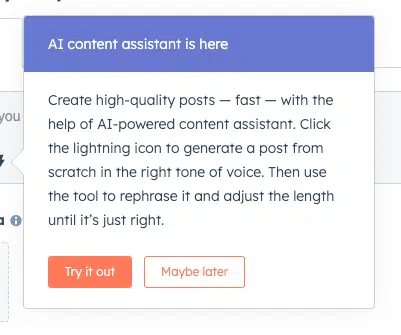It’s been a whirlwind 9 months of AI hype — a lot potential and concern. AI is right here to remain, poised to rework how your organization operates and engages with clients.
As AI-based purposes make their approach into enterprise organizations, right here’s how to make sure you are able to make use of them correctly.
A take a look at AI’s professionals and cons
Day-after-day, I hear from colleagues about methods they’ve used generative AI to both pace up a course of or create content material. One colleague forwarded a LinkedIn put up from Eric Partaker with a graphic (created by generative AI!) exhibiting 120 generative AI instruments. What a treasure trove to mine!
Firms have seemingly appeared out of nowhere, providing myriad methods to leverage AI in inventive endeavors. However as a lot as generative AI has captured the creativeness, AI’s potential for remodeling the shopper expertise throughout virtually each trade and buyer touchpoint is what’s going to in the end ignite pleasure.
Yesterday, I spent 45 minutes reserving what ought to have been a easy short-haul flight. I misplaced depend of the variety of screens I clicked by means of. I envision a day once I can use a pure language interface to inform an AI-driven assistant the place I need to go and when after which let it do the arduous work of getting it executed.
But, there’s nonetheless concern, uncertainty and doubt — starting from issues about accuracy and hallucinations all the best way to AI destroying humanity. A professor pal summed it up with a tongue-in-cheek Fb put up:
“So … I’ve been working rather a lot with chatGPT in growing a brand new course. I’m at all times very well mannered in my interactions with this system on the belief that (1) every little thing that I write to ChatGPT will likely be saved ceaselessly and (2) if I’m good to our soon-to-be AI Overlords … perhaps they’ll be good to me and never ship me to a mining colony someplace within the boonies…”
Dig deeper: Synthetic Intelligence: A newbie’s information
The place are we headed?
No matter your stance, it’s time to simply accept that AI is right here and can influence your online business. It’s unlikely that there will likely be a sudden “flip a swap” second. AI-based expertise purposes will roll out like most expertise, one product at a time.
In lots of circumstances, AI expertise will initially yield incremental adjustments to operations and features. Over time, as AI expertise evolves, we’ll see a much bigger influence as workflows are optimized and buyer touchpoints develop into extra clever.
From a advertising and marketing perspective, it’s important to have a method that encompasses the place and the way you’ll use AI, establishing the guardrails to make sure that everyone seems to be working to a typical algorithm and parameters and a plan to ensure your information is able to be leveraged by varied AI purposes.
Defining your position is the start line:
- Are you and your organization an AI person, an AI supplier or each?
- Are you leveraging AI instruments or are you delivering AI-enabled instruments?
Most of us will likely be AI customers (the proliferation of ChatGPT factors to that), and a few of us may also be AI suppliers.
What to contemplate as AI customers
As you take into account your technique for utilizing AI as a part of your advertising and marketing efforts, it’s essential to have a look at generative AI purposes as discrete from different AI-enabled purposes.
Utilizing generative AI purposes requires participating with an exterior interface. There isn’t any inside information dependency and only a few safety dangers. There at the moment are many generative AI instruments to select from, as evidenced by the graphic above.
Generative AI capabilities are popping up in established apps and merchandise. HubSpot, for instance, has an built-in AI assistant to assist create and polish content material.

Chances are high that your workforce members are already utilizing these instruments to create and edit content material. In the event you haven’t already executed so, body the parameters across the utilization of generative AI in your group and tackle the next:
- Which instruments are permitted to be used and tips on how to get hold of approval to make use of new instruments.
- When and the way these instruments ought to be used.
- Content material creation vs. content material modifying
- Content material propagation. One of many actual dangers in utilizing generative AI is that it will likely be used to spice up the quantity of content material being distributed. That could possibly be a very good factor if it assists with personalization however a nasty factor whether it is used to create a number of variations of basically the identical content material, which in flip is used to bombard prospects and clients. I usually use Bard and ChatGPT to shine content material that I’ve written and use the command “enhance this” or “rewrite this” — I may simply do this time and again to get a number of respectable variants of the identical content material after which use these variants as posts, emails and so forth. making a content material tsunami that might dilute, not improve, my advertising and marketing efforts.
- How content material created by these instruments ought to be attributed. How are copyrights dealt with (time to have interaction authorized)? If an worker has used generative AI to create content material, ought to that be disclosed? If that’s the case, how and when?
- The best way to fact-check a reference generated by one in every of these instruments if the reference is to be cited. We all know that generative AI can create false references. How are you going to handle this?
- Content material ethics. Now you can use generative AI to create audio recordsdata utilizing one other individual’s voice — what’s your place on this?
We’re in new territory right here, and I’d advocate participating your complete workforce in establishing parameters and tips. These ought to be commonly reviewed to handle new purposes and any points that floor.
Although we at the moment have a tendency to make use of AI and generative AI interchangeably in terms of advertising and marketing, many different AI-enabled purposes can add worth to your advertising and marketing stack. Most of those purposes require using your information to ship worth in prospect concentrating on, creating and refining the shopper expertise, analyzing efficiency and different advertising and marketing features.
Bear in mind the previous phrase “rubbish in/rubbish out”? It holds true right here. In case your information just isn’t clear, complete and freed from artifacts, you’ll not derive any advantages from these purposes.
I proceed to be amazed at what number of advertising and marketing departments shouldn’t have a transparent view and understanding of what information they’ve, the place it resides, the way it passes from software to software, how clear the info is and what information is lacking.
In case your division is one in every of these, now’s the time to take motion to doc the main points of your stack and the related information assortment, storage, sharing and distribution mechanisms after which work to make sure that every little thing is being collected, saved, shared and distributed as required.
AI will discover its approach into nearly each advertising and marketing expertise software over time, and it’ll solely carry out nicely whether it is working with a clear, full and correct information set.
What to contemplate as AI suppliers
If your organization is a supplier of an AI-enabled software, you as a advertising and marketing chief, will naturally gravitate to speaking how and why your software leverages AI and the profit that utilizing AI delivers to your clients.
Speaking how your organization thinks about AI ethics is probably not prime of thoughts. Much like the way you publish information privateness compliance data, try to be interested by publishing an AI ethics assertion.
That is in a short time going to be one thing that any potential buyer, and specifically, their infosec division, will need to overview as a part of their qualification course of. Now’s the time to behave on this.
Salesforce has been speaking about AI ethics for a very long time, and firms are more and more publishing AI ethics statements, together with Adobe, WellSaid and Resemble AI.
Externally, a number of teams have shaped to handle AI security. They embody:
The U.S. authorities is attempting to handle AI security and has proposed an AI Invoice of Rights. In addition they convened a gaggle of tech leaders (Amazon, Anthropic, Google, Meta, Microsoft, Inflection and OpenAI) to determine a dedication to testing and securing AI developments and watermarking AI-generated content material.
These exterior efforts are laudable, however they don’t negate the necessity for every AI developer to determine their very own AI boundaries and ethics. The reality is that we don’t understand how AI and AI purposes will evolve.
It has been prompt that the tempo of improvement will exceed our skill to conceptualize what’s potential, which nearly ensures that capabilities and new purposes will emerge that we’ve by no means imagined.
Taking motion
As AI-based purposes make their approach into enterprise organizations, our goal ought to be to make sure that we’re able to make the most of them correctly. Meaning:
- Establishing guidelines for using AI internally.
- Making certain that our tech stacks are nicely documented, together with information flows, and that information is of top quality.
- In case you are a supplier of an AI-enabled product, set up your place on AI ethics after which publish an AI ethics assertion.
Get MarTech! Every day. Free. In your inbox.
Opinions expressed on this article are these of the visitor creator and never essentially MarTech. Workers authors are listed right here.

